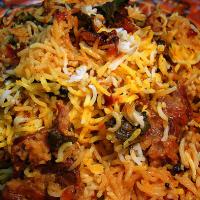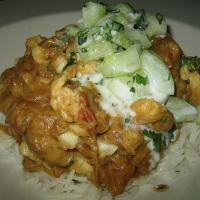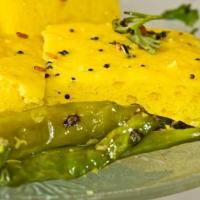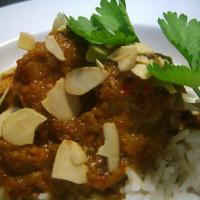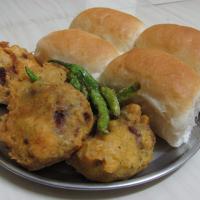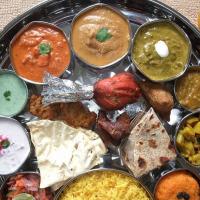Andaman & Nicobar Islands is a melting pot of Indian Culture. This is even reflected in the food & Cuisine of the local people of these Islands.
The traditional cuisine of the island was, naturally, based around the food available locally. Sea food like lobster, prawn and several other sea-fish dishes constitute the principle cuisine of Andaman and Nicobar islands.
Cuisines of India
Andhra Pradesh is famous for its hot and spicy cuisine along with its rich cultural heritage. The cuisine of Andhra Pradesh includes both the original Andhra cuisine and the Hyderabadi cuisine, having a Mughlai influence. Out of these two cuisines, the former one is more hot and spicy. The traditional delicacies of Andhra are absolutely mouthwatering having a liberal use of spices.
Every meal that is snacks, lunch, dinner, etc, have their own specialty. The eating habits are quite varied as there is a mixture of Hindu and Muslim styles of eating. The Andhra cuisine is mainly vegetarian and only in the coastal areas seafood is preferred. The staple food of Andhra Pradesh is Rice, which is served with sambar. It is also served with other lentil preparations along with vegetables.
Rice beer is a famous beverage of Arunachal Pradesh as an alcoholic drink. There are different varieties of rice beer with different flavours.
Thukpa is another traditional dish common among "monpa" a tribe of Arunachal.
The staple food is rice along with fish, meat and lots of green vegetables. Different varieties of rice are available. Lettuce is the most common and preferred vegetable of all, prepared by boiling it with ginger, coriander and green chillies. Boiled rice cakes wrapped in leaves is a famous snack.
Assamese cuisine is the cuisine of Assam, a state in North-East India. It is a mixture of different indigenous styles with considerable regional variations and some external influences. It is characterized by very little use of spices but strong flavors due mainly to the use of endemic exotic herbs, fruits and vegetables that are either fresh, dried or fermented. Fish is widely used, and birds like duck, pigeon etc. are very popular. Preparations are rarely elaborate—the practice of Bhuna, the gentle frying of spices before the addition of the main ingredients so common in Indian cooking, is absent in the cuisine of Assam.
Bihari cuisine is eaten mainly in Bihar, Eastern Uttar Pradesh, Pakistan, Bangladesh, Nepal, Mauritius, Fiji, Guyana, and Trinidad and Tobago as these are they places where [[Bihari people|Bihar••• presence. Bihari cuisine is predominantly vegetarian because traditional Bihar society influenced by Buddhist and Hindu values of non-violence did not eat eggs, chicken, fish and other animal products. However there is also a tradition of meat-eating and fish dishes are especially common due to the number of rivers in Bihar such as the Sone, Gandak and the Ganges. There are also numerous Bihari meat dishes with chicken and mutton being the most common.
A visit to Chandigarh is incomplete without tasting its mouth-watering and lip-smacking delicacies. The people of the city are all-time food lovers, who prefer exotic preparations with lots of spices. As in any other place of Punjab, the traditional food of Chandigarh is spicy and makes use of oil and ghee to a considerably higher extent. There are no intricate marinades or exotic sauces, but an exuberant use of spices with a liberal addition of oil or ghee. The people prefer wheat items to rice. Among the different wheat items, the most popular ones are Makkee ki Roti (chapatti made of corn) and stuffed parathas.
Chattisgarh, the newly created state carved out from the state of Madhya Pradesh has been able to carve out an identity of its own even within a short duration of its existence as a separate identity. Chattisgarh, flanked by the Madhya Pradesh, Maharashtra, Andhra Pradesh, Orissa, Jharkhand and Uttar Pradesh have imbibed some elements from its neighboring states, but inspite of that has been able to retain its individuality in terms of its culture and the cuisines of Chattisgarh.
The food in Dadra and Nagar Haveli is very strongly influenced by neighbouring state Gujarat. Almost always strictly vegetarian, Gujarati cuisine is unlike any other Indian cuisine. The difference lies in the unusual blending of the sweet with the salty into a harmonious whole. The grand spread of Gujarati cuisine can be glimpsed and savoured in the very popular "Gujarati Thali".
Daman and Diu is much influenced by Gujarat due to its nearness. The cuisine of Daman and Diu is interesting. The Papri of the region is famous. Papri is nothing but boiled, salty and sweet peas. The streets of Daman have bars that sell beer, scotch whisky and feni. Tody is also found in abundance. The Octobers are the times when crabs and lobsters form a part of the cuisine. The region also offers seafood and also Chinese cuisine. There are also distinct possibilities of treating one’s taste buds to some Parsee foods.
Everyone in Delhi loves eating. When people in Bombay and Bangalore are either partying or drinking, Delhites are, you guessed it, eating.
Walk into any wedding, party or social occasion and you will see huge tables groaning under an astonishing array of mouthwatering – and sometimes nose-watering too – dishes emanating exquisite aromas and fragrance. Usually, in the Delhi social scene, a perfunctory ‘hello’ is followed by the hostess indicating to the guest where the food has been laid; just what the guest had been too polite to ask himself but was, of course, dying to know.
Goan cuisine consists of regional foods popular in Goa, located along India's west coast along the Arabian Sea. Seafood, coconut milk, rice and paste are main ingredients of Goan delicacies. The area is located in a tropical climate, and spices and flavors are intense. Use of Kokum is another distinct feature. Goan food cannot be considered complete without fish. It is similar to the Malvani cuisine/ Konkani cuisine.
The cuisine of Goa is influenced by its Hindu origins, four hundred years of Portuguese colonialism, and modern techniques. The state is frequented by tourists visiting its beaches and historic sites, so its food has an international aspect.
Gujarati cuisine refers to the cuisine of the Gujaratis from India, who are predominant in western-India. It is primarily vegetarian. The typical Gujarati Thali consists of Roti (a flat bread made from wheat flour), daal or kadhi, rice, and sabzi/shaak (a dish made up of different combinations of vegetables and spices, which may be stir fried, spicy or sweet). Cuisine can vary widely in flavor and heat, depending on a given family's tastes as well as the region of Gujarat they are from. North Gujarat, Kathiawad, Kachchh, and South Gujarat are the four major regions of Gujarat that all bring their own style to Gujarati food. Many Gujarati dishes are distinctively sweet, salty, and spicy at the same time. They can also be very oily.
Simplicity is the key word when it boils down to eating and drinking for the Harayanavis, essentially living in rural areas. The 2-meal a day routine is followed in rural areas with the afternoon hunger pangs being put to rest in the fields.
That’s for the villagers; they don’t eat breakfast and go straight to lunch which consists of loaves made from flour (either bajra, wheat or gram) with salt and enough green chillies to put anyone else on fire. The evening meal – normally after a hefty drinking bout for the men – is another simple affair ofkhichri (porridge) of bajra and moong or rice.
The Cuisine of Himachal Pradesh – the north Indian state lying at the foothills of the Himalayas – boasts of a uniqueness of its own. Influence of the neighboring lands of Punjab and Tibet is clearly evident in the Himachal cuisine. Besides, the geographical and climatic conditions of the state have a strong effect on the dishes of Himachal Pradesh and the way they are prepared. The day-to-day cuisine of Himachal Pradesh is simple and very much similar to that of other north Indian states. Rice, paddy and maize constitute the staple diet of the people here.
Kashmiri cuisine has evolved over hundreds of years. The first major influence was the food of the Kashmiri Buddhists and Pandits, the Hindus of the valley. The cuisine was then influenced by the cultures which arrived with the invasion of Kashmir by Timur from the region of modern Uzbekistan. Subsequently, it has been strongly influenced by the cuisines of Central Asian, Persia, and the North Indian plains.
The most notable ingredient in Kashmir cuisine is mutton, of which there are over 30 varieties. Also to be noted are Balti curries, popular in the United Kingdom for their exotic tastes, that were originally brought by Pakistani immigrants hailing from the Baltistan region of Pakistan-administered Kashmir.
Kashmiri Muslim Cuisine – Wazwan
Traditional Jharkhand cuisine is equally vegetarian as well as non-vegetarian. These traditional dishes are not available at the restaurants as they have not been commercialised. However on a visit to a tribal village or a tribal wedding in a remote area one can get a chance to taste such exotic food. All preparation except the picles and festive ones are low on oil and spices.
The Cuisine of Karnataka includes many vegetarian and non-vegetarian cuisines. The varieties reflect influences from the food habits of many regions and communities from the three neighbouring South Indian states, as well as the state of Maharashtra to its north. Some typical dishes include Bisi bele bath, Jolada rotti, Chapati, Ragi rotti, Akki rotti, Saaru, Huli, Vangi Bath, Khara Bath, Kesari Bath, Davanagere Benne Dosa, Ragi mudde, and Uppittu. The famous Masala Dosa traces its origin to Udupi cuisine. Plain and Rave Idli, MysoreMasala Dosa and Maddur Vade are popular in South Karnataka. Coorg district is famous for spicy varieties of pork curries while coastal Karnataka boasts of many tasty seafood specialities. Among sweets, Mysore Pak, Dharwad pedha, Chiroti are well known.
The cuisine of Kerala is linked in all its richness to the history, geography, demography and culture of the land. Since many of Kerala's Hindus are vegetarian by religion, and because Kerala has large minorities of Muslims and Christians that are predominantly non-vegetarians, Kerala cuisine has a multitude of both vegetarian and dishes prepared using fish, poultry and meat.
The cuisine in Madhya Pradesh varies from region to region. The north and west are mainly wheat-and-meat based, while the wetter south and east are rice and fish dominated.
Gwalior and Indore abound in milk and milk-based preparations. Bhopal produces exquisite meat and fish dishes, of which the spicy rogan josh, delicious korma, luscious keema, all-season favourite biryani pilaf and succulent kababs such as shami and seekh are almost legendary. But heavens dont even think of trying all of these together unless you want to get the stomach upset of the century. They are extremely rich, spicy and creamy dishes.
Maharashtrian (or Marathi) cuisine is cuisine of the Marathi people, those from the state of Maharashtra in India. Maharashtrian cuisine covers a range from being mild to very spicy dishes. Wheat, rice, jowar, vegetables, lentils and fruit form important components of Maharashtrian diet. Popular dishes include puran poli, ukdiche Modak and batata wada.
Manipuri cuisine is simple, organic and healthy. Dishes are typically spicy foods that use chili pepper rather than Garam masala .
Basic Diet
The staple diet of Manipur consists of rice, leafy vegetables, and fish. Manipuris typically raise vegetables in a kitchen garden and rear fish in small ponds around their house.
Sample Dishes
Eromba is a chutney of boiled vegetables or potatoes with a lot of red chiles, tomatoes (optional) and dried fish salted to taste. It is garnished with chopped onions and coriander leaves.
Meghalayan cuisine is the local cuisine of one of the Indian States.Meghalaya, also one of the seven sisters and home of three Mongoloid tribes, has a unique cuisine of its own, different from other states in the north east of India. The staple food of the people is rice with spicy meat and fish preparations. They rear goats, pigs, fowl, ducks and cows and relish their meat. The popular dishes are Jadoh, Ki Kpu, Tung-toh, and pickled bamboo shoots.
Naga cuisine, of the Naga people, is known for exotic meats but simple and flavorful ingredients. The meat and fish used are often smoked, dried or fermented.
Oriya cuisine refers to the cooking of the eastern Indian state of Orissa. Foods from this area are rich and varied, while relying heavily on local ingredients. The flavors are usually subtle and delicately spiced, quite unlike the fiery curries typically associated with Indian cuisine. Fish and other seafood such as crab and shrimp are very popular. Chicken and mutton are also consumed. Only 6% of the population of Orissa is vegetarian, and this is reflected in its cuisine.
Punjabi cuisine (from the Punjab region of northwestern India and eastern Pakistan) can be non-vegetarian or completely vegetarian. One of the main features of Punjabi cuisine is its diverse range of dishes. Home cooked and restaurant Punjabi cuisine can vary significantly, with restaurant style using large amounts of clarified butter, known locally as ghee, with liberal amounts of butter and cream with home cooked concentrating on mainly upon preparations with Whole Wheat, Rice and other ingredients flavored with masalas (spices). Roh Di Kheer, is cooked using rice. Rice is cooked for a long time in sugar cane juice.

